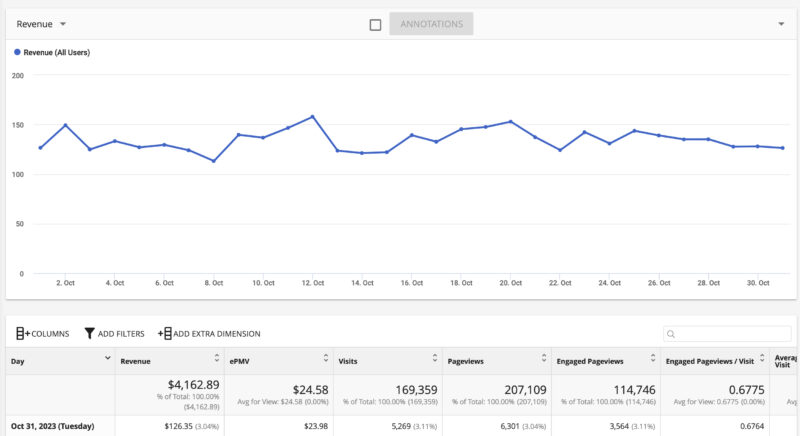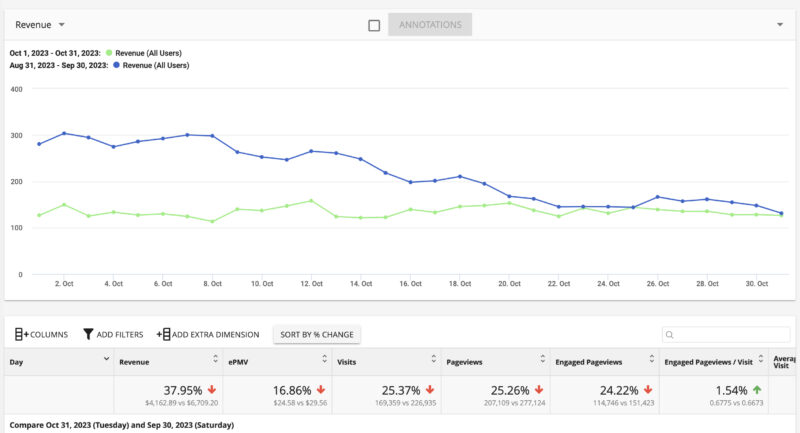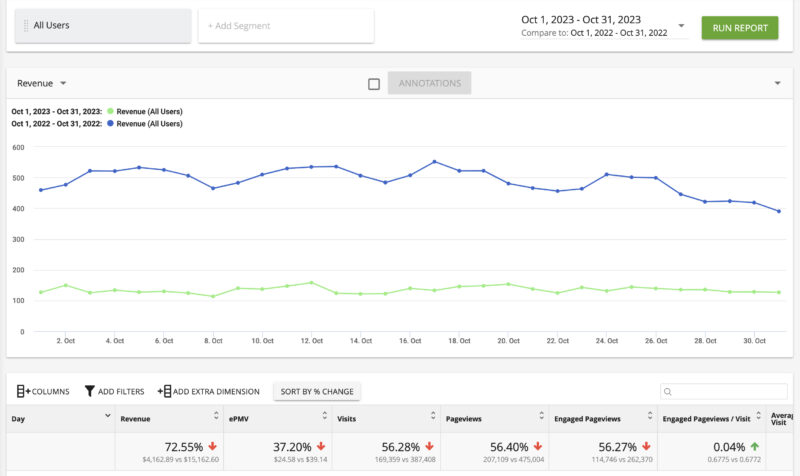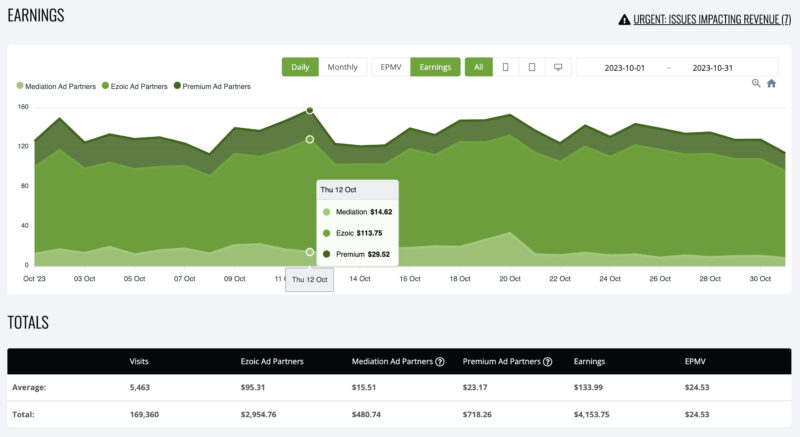Chaos continues to grip the internet in its clutches, as content publishers around the globe (including us) are scrambling to figure out what’s going on at Google. Major algorithm changes and policy updates have since resulted in sites losing huge chunks of traffic. As a result, they’re seeing their monetization earnings slide off a cliff. Unfortunately, our case study domain too has seen a new low, earning just $4,162 in October 2023.
We’ve been monetising our case study domain with display ads powered by Ezoic for the last 37 months. In that time, especially early on, our case study domain has grown massively. But, ever since September 2022, it’s never been the same, and we’ve experienced a gradual decline in traffic and ad revenue. We now know why, and we’ll discuss more of that later on. For now, though, let’s dissect October 2023’s ad revenues…
The past month’s (October) ad earnings came out to $4,162, marking an enormous ~37.95% drop when you compare it to the month before (September). Moreover, October 2023 saw about 169,000 site visits, as well as over 207,000 pageviews, whereas nearly 115,000 of them were ‘engaged’ pageviews. Though it may look good in a vacuum, compared to September, it’s a ~25.37%, ~25.26%, and ~24.22% dip, respectively.
Granted, a part of it was out of our control, as October 2023’s EMPVs (earnings per thousand visitors) were averaging at around ~$24.58, which was another ~16.86% decline compared to September. If you’re seeing the same drop-offs in site traffic and ad revenue for your blog site or content creation platform, then you’re practically experiencing what most other content creators and bloggers on the internet are facing, too.
| October 2023 Ad Revenue From Ezoic | ||
|---|---|---|
| Revenue (Total) | $4,162 | |
| Traffic | Visits | 169,359 |
| Pageviews | 207,109 | |
| Engaged Pageviews | 114,746 | |
| ePMV (Earnings Per Thousand Visitors) | $24.58 | |
Google’s Helpful Content Update Guidelines
So, you might be wondering, why is this so? Why is my site traffic (and subsequently, ad revenue) falling off lately? Well, the concise answer is… Google. The more insightful answer would be… Google’s Core Updates. If you’ve been through our monthly revenue reports before, then you might’ve noticed me mentioning it in our last report. TL;DR, Google’s been very proactive with their search engine algorithm updates as of late.
In the past, Core Updates have always been consequential to some degree concerning how Google updates and tweaks its search engine. Thus, for sites that rely heavily on traffic from Google (in our case, nearly 2/3 of site traffic came from google.com), this can make a major impact on your site traffic. Nevertheless, they were never usually too frequent (only once per every other month), and any fine-tuning was often quite subtle.
With that being said, things have been shaking up at Google, and SEOs worldwide are still trying to analyze that with a microscope. Mainly, Core Updates have been getting more frequent. We’ve already gotten two Core Updates in as many months. Moreover, those Core Updates are more assertive, with Google working towards removing unhelpful content and spam on their search results, and generally polishing things up.
This was all enshrined in Google’s new Helpful Content Update (HCU) guidelines. Here, Google aims to show greater priority towards pushing sites further up their search results and rankings if their content is deemed to be ‘helpful’. This entails content that’s concise, straight-to-the-point, offers helpful advice or information, and has good EEAT (experience, expertise, authoritativeness, and trustworthiness) on the part of its authors.
Changing & Evolving How We’ve Analysed SEO
This entirely uproots the SEO guidelines and understanding that our case study domain was built upon which we’ve become accustomed to over the past few years. Primarily, our case study domain, previously, had its content be created upon a tried-and-trusted template… Long-form SEO content, mention specific keywords, ample internal & external linking, and make it as in-depth and as detailed as possible to serve the user.
Now, it’s different. Google now prioritizes short-form and concise content, which answers the search intent as straightforwardly as possible. On top of that, there’s a far lesser priority by Google’s search engine when it comes to emphasizing on specific keywords or how many internal & external links you have in a blog or article. It’s not just our case study domain either, as our rivals too have been hit very hard (if not, harder).
Thankfully, some of the fundamentals of creating good content are the same, as I’ve outlined in my training course, if you’d like to join. Besides that, while the new HCU updates don’t prioritize keywords as much, any form of keyword research is still a key step in optimizing your site’s SEO. So, do check out our guides on how to do keyword research, as well as our on-page SEO checklist, and our look at the best free keyword tools.
In addition, my in-depth analysis and insights into making money online from content creation websites is a handy free resource that you can check out, too. With this in mind, we are making plans (although, a lot of it is experimental at this point, as even expert SEOs haven’t truly figured out what’s most optimal with Google’s HCU guidelines) on how we can adjust our content creation process to adjust for Google’s HCU.
Forging Future Plans, Experimentations, & Moving Forward
As I mentioned earlier, most of my content strategy was seeing what keywords would rank well with search engines (mainly Google) and creating content for that. In essence, I was creating content for search engines, not necessarily for the users in mind. This time, we’re looking for niche (yet relevant) keywords and topics to work on, and we’re refining on a new, HCU-optimised formatting structure for all our written content.
This includes a much shorter word count – less than 1,000 words, compared to the 3,000++ that we were doing before. In addition, our content is now being written to get the answers that the searchers and users might be looking for right off the bat, and keeping them concise and easy to read at a glance. In the past, most of our articles were supremely in-depth, and covered additional sub-topics that may not always be desired.
Another major change is optimizing our EEAT; experience, expertise, authoritativeness, and trustworthiness. For this, we’ve created detailed author pages to outline how and why we could be trusted by the readers as an authoritative figure on a specific niche and topic. Additionally, we also add further anecdotes of our first-hand experiences and expertise about a certain niche, topic or subject matter, when making content for it.
In the meantime, if you are trying to make the best of lost site traffic and ad revenues, Ezoic has long been a preferred ad network provider for our case study domain. So, do check out our insights into how to optimize Ezoic for maximum ad revenue and how to get started with Ezoic. Aside from this, there are loads more that I wanted to discuss about what’s been changing lately, so check out this video below to find out more…







